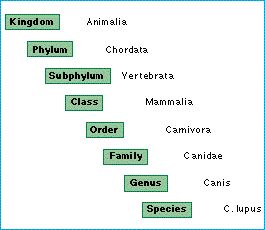Taxonomic hierarchy

Since Linnaeus, the father of taxonomy, species have been arranged in a taxonomic hierarchy.
Linnaeus' hierarchy:
• Species are grouped in genera. The gray wolf species Canis lupus and the golden jackal Canis aureus , for example, are grouped in the genus Canis.
• Genera are grouped into families; the genus containing dogs and wolves combines with several other genera, such as the fox genus Vulpes, to make up the family Canidae.
• Several families combine to make up an Order (Carnivora, in this example).
• Orders make a Class (Mammalia ).
• Classes make a Phylum (Chordata ).
• Phyla make up one of the five Kingdoms (Animalia ).
Each species, therefore, is a member of a genus, a family, an order, and so on. The problem is how to group species into higher categories. This is an important theoretical issue with conflicting taxonomic schools of classification.
Figure: the taxonomic classification of the gray wolf Canis lupus.
| Next |



